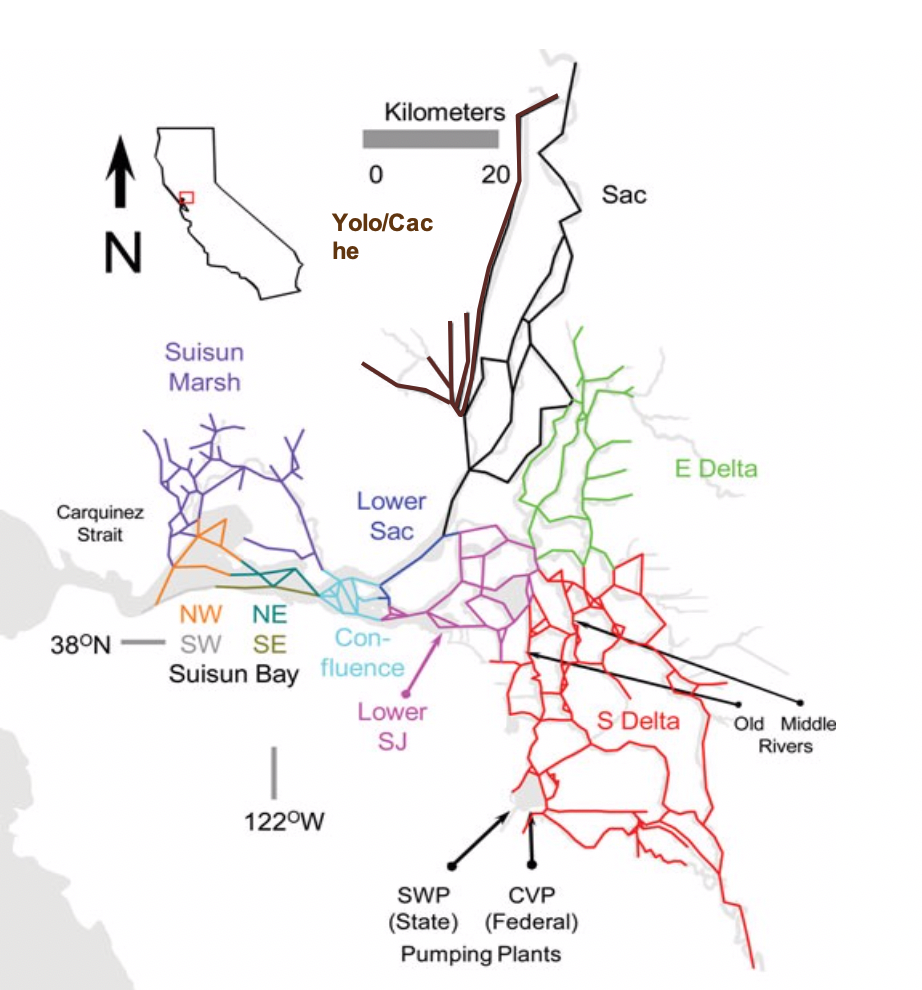May 11, 2018
Participants:
Ben Geske, Scott Hamilton, Josh Israel, Jim Peterson, Mike Urkov, Rod Wittler, Kathy Marcinkevage, Dave Mooney, Erin McCreless, Matt Nobriga, Evan Carson, Catrina, Bruce DiGennaro, Victor Pacheco
Discussion of geographic regions for Delta Smelt
Scott Hamilton’s model has slightly different region boundaries than the ones proposed here (see map below). Scott had tweaked the Rose et al. (2013) regions slightly so they conform with his regions, which are based on a combination of ecology (where we know smelt are) plus data availability for different regions.
The Rose et al. (2013) model divided Suisun into 4 regions: NW, NE, SW, SE. Newman just divided Suisun into North and South; the South has faster moving water whereas the North has longer residency time. Scott used the North-South division in his model, with North corresponding to Rose et al.’s NW and NE and the South corresponding to Rose et al.’s SW and SE. There was a comment that the importance of the lower San Joaquin, from Rose et al.’s model, varies by season, and a question of whether the San Joaquin should be included in the South or East Delta. Scott commented that this may not make much difference, and it may be better to organize regions such that sampling and/or monitoring stations are evenly distributed among regions. Scott has a map of these stations.
Scott agreed to create more polished maps. Jim said we will likely run two different models for prioritizing actions, one using the regions from Scott/Dennis’s model and the other using regions from the modified Rose et al. (2013) model. Then, if a particular action is predicted by one model to have a greater benefit for smelt than is predicted by the other model, we can assess whether the difference is due to differences in regional delineations or differences in the modeling process.
There was agreement that ongoing conversations about how to break up regions may not be particularly useful at this stage and will slow down the process. Will was unable to attend the meeting but it was suggested that the regional delineations he used shouldn’t be further modified or broken up, as they are consistent with Rose et al. (2013) and changing them now will add confusion.
Discussion of Delta Smelt and Chinook influence diagrams
These are complicated figures with many factors and arrows; it was asked whether the goal is to use data and quantify every arrow? Jim answered that at this stage, the diagrams are meant to identify linkages in the system and serve as communication devices. When the time comes to model the system, some factors will have to be excluded because there is no data for them. This is the approach being taken in the CVPIA project.
Other discussion points about the influence diagrams:
Scott’s model is based on individual life stages; he believes it would be easier to model management actions as they relate to each individual life stage.
It was noted that the Chinook diagrams have some linkages that are not included in the Smelt diagrams, but they should be the same.
Question: when discussing ecological management actions, should tides be included, as they are outside the realm of what can be managed?
- Answer: this depends on the action and the scale at which it will be implemented.
Question/comment: for each action, are we interested in impacts at fine scales, or impacts that will scale up to be measureable at the population level? As an example, setting back the levee at the Head of Old River will not change the parts of the estuary where smelt occur. There was discussion of spawning habitat possibly being affected by this action, as preferred spawning habitat is a data gap for smelt; however, smelt only seldom ascend the SJ River that far so creating spawning habitat in this area would not have a population level effect.
Discussion of hatcheries. Releasing adults is easiest, but the timing is important, and there is potential for high mortality before adults reproduce. It would be good to be more specific about the actions we’re discussing, for example in this case, specify exactly how many eggs or adults would be released and when.
Generally, we need to be more specific about the proposed actions. We can do this for many of the actions, but the flow-related ones will require working more closely with operations people who manage water.
** See attached for modified influence diagrams, with linkages added or removed based on discussion of specific actions for smelt and Chinook.
Next steps:
- Model the remaining objectives and determine whether to include them in the pilot evaluation. These would likely be an expert-driven exercise. We will discuss this at the next in-person meeting.
- Meeting attendees should review notes and make changes/suggestions as needed.
Delta Smelt Regions

Chinook Regions
